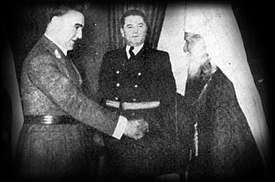Croatian Orthodox Church
The Croatian Orthodox Church (Croatian: Hrvatska pravoslavna crkva) was a religious body created during World War II by the Fascist Ustaše regime in the Independent State of Croatia (NDH). It was created in order to assimilate the large Serb minority and also to unite other Orthodox communities into a state-based Orthodox Church.

NDH authorities finally made a move to organize a domestic Orthodox Church. This was part of a policy to eliminate Serb culture from Axis Croatia. The church lasted from 1942–45, and was intended to serve as a national church to which Serbs living in Croatia would convert, thus making it possible to describe them as "Croats of Orthodox faith". It was only recognized by one other Orthodox church, the Romanian Orthodox Church, on 4 August 1944[1] (at the time, Romania was also under the control of the Fascist regime of Ion Antonescu). The Croatian Orthodox Church was managed by Montenegrin nationalist Savić Marković Štedimlija. There were some discussions during the 1990s, after the breakup of Yugoslavia, regarding the revival of such a church.
History
The Croatian Orthodox Church was created, to be considered one of the three faiths to which Croats could officially belong (the main ones being Catholicism and Islam). The reason for the creation of this Church was the loss of a significant part of the territory to Partisans and Chetniks, as well as the additional German pressure over growing anarchy in the country, which is why a concession to the Serb population was deemed necessary.[2]
The church was formed by a government statute (No. XC-800-Z-1942) on 4 April 1942. On 5 June, using a statute issued by the government, the church's constitution was passed. On 7 June, Germogen became the only Orthodox Metropolitan of Zagreb. The church lasted until the collapse of the NDH. Its leader Germogen, Metropolitan of Zagreb and previously a priest of the Russian Orthodox Church Outside Russia, who is said to have had Uniate sympathies, was shot dead by Partisans after the war as a collaborator. Many or most of the church's priests were Serbian priests compelled to change churches in order to survive, together with defrocked Orthodox priests, émigré priests from Russia, and some Uniate and Roman Catholic priests.
Before the Croatian Orthodox Church was formed, the NDH officially described the Eastern Orthodox Church as the "Greek-Eastern Church", and would refer to it as the "Schismatic Church" or the "Greek non-Uniate Church". The Ustasha wanted to make their church legitimate; they asked for recognition from the Ecumenical Patriarch in Istanbul.
Proposals for a revival
On 6 March 1993, Juraj Kolaric, dean of the Catholic Faculty of Theology in Zagreb, was reported by the Tanjug news agency as stating that the "Orthodox Church in Croatia should be organized along the Macedonian principle, with its patriarch, and break away as far as territory was concerned, from Serbia”.[3] Kolaric tried several times to establish such a church by the "Croat Orthodox believers and possible Croatian Orthodox clergy, because then all the conditions for an autocephalous church would be met". Kolaric claimed that if such a church were formed, it would eventually by recognized by the Patriarch of Constantinople as the Serbian Orthodox Church would never again be present in Croatia.
References
- Krišto, Jure. Sukob simbola: Politika, vjere i ideologije u Nezavisnoj Državi Hrvatskoj. Globus, Zagreb 2001. (pg. 258)
- Kolaric 2007, pp. 232–234
- "The Orthodox Church in Croatia". Vreme News Digest Agency. 15 March 1993. Retrieved 11 Nov 2016.
Sources
- Paris, Edmond (1961). Genocide in Satellite Croatia, 1941-1945: A Record of Racial and Religious Persecutions and Massacres. Chicago: American Institute for Balkan Affairs.CS1 maint: ref=harv (link)
- Veljko Đ. Đurić (1989). Ustaše i pravoslavlje: hrvatska pravoslavna crkva. Beletra.
- Gojo Riste Dakina (1994). Genocide Over the Serbs in the Independent State of Croatia: Be Catholic Or Die. Institute of Contemporary History.
- Rivelli, Marco Aurelio (1998). Le génocide occulté: État Indépendant de Croatie 1941–1945 [Hidden Genocide: The Independent State of Croatia 1941–1945] (in French). Lausanne: L'age d'Homme.CS1 maint: ref=harv (link)
- Rivelli, Marco Aurelio (1999). L'arcivescovo del genocidio: Monsignor Stepinac, il Vaticano e la dittatura ustascia in Croazia, 1941-1945 [The Archbishop of Genocide: Monsignor Stepinac, the Vatican and the Ustaše dictatorship in Croatia, 1941-1945] (in Italian). Milano: Kaos.CS1 maint: ref=harv (link)
- Bartulin, Nevenko (October 2007). "Ideologija nacije i rase: ustaški režim i politika prema Srbima u Nezavisnoj Državi Hrvatskoj 1941-1945" (PDF). Radovi (in Croatian). Institute of Croatian History. 39 (1): 209–241. Retrieved 9 January 2015.CS1 maint: ref=harv (link)
- Novak, Viktor (2011). Magnum Crimen: Half a Century of Clericalism in Croatia. 1. Jagodina: Gambit.CS1 maint: ref=harv (link)
- Novak, Viktor (2011). Magnum Crimen: Half a Century of Clericalism in Croatia. 2. Jagodina: Gambit.CS1 maint: ref=harv (link)
External links
- Savic Markovic Stedimlija - Ideologist of "Red Croatia", njegos.org; accessed 20 April 2015
- New Attacks on the Serbian Orthodox Church, hri.org, 4 April 1996
- The Orthodox Church in Croatia, Vreme News Digest Agency No 77, 15 March 1993
- Official website of the Croatian Orthodox Community, hrvatskipravoslavci.com; accessed 20 April 2015 (in Croatian)